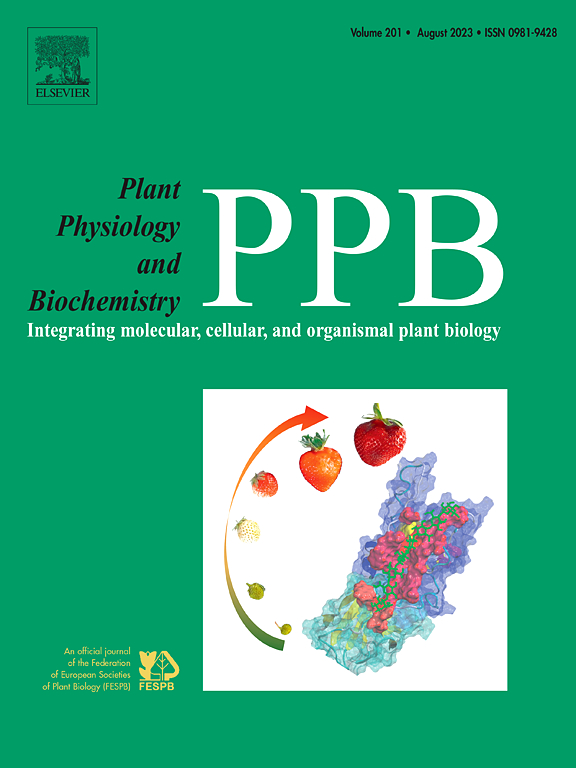对乙烯不敏感的番茄突变体Never ripe在磷胁迫下表现出较好的生长和磷利用效率
IF 5.7
2区 生物学
Q1 PLANT SCIENCES
引用次数: 0
摘要
磷(P)是生物分子的结构和功能成分所必需的大量营养素;磷稳态与植物激素信号通路(如乙烯)相互作用,导致植物生长发育的响应。番茄植株(Solanum lycopersicum L.)已被用作生理和生化研究的模型,乙烯不敏感突变体Never ripe (Nr)有助于了解乙烯如何干扰和协调生物过程,包括对P的营养胁迫的反应。在这里,我们旨在评估Nr植株对P胁迫(缺P和过量- 2× P)的反应,以了解乙烯信号传导和P稳态之间的相互作用。为此,将野生型(WT)和Nr基因型的番茄植株在生长室内条件下用适应的霍格兰(Hoagland)溶液进行施肥,两因子按因子排列,分布在6个处理中,2(基因型)x 3 (P水平):(i)无P的WT;(ii) WT控制;(iii) WT P过量;(iv)无P时的Nr;(v)控制的Nr;(vi)磷含量超标的Nr。植物生长和产量、光合、生化和营养参数被量化。在所有处理中,生物特征参数的最高值大多出现在Nr中,并且影响了果实的产量,在缺磷情况下,突变体的产量高于WT。两种基因型的光合参数,如CO2同化和气孔导度,在缺磷条件下均较高。Nr植株碳水化合物含量较低,氨基酸和蛋白质含量较高,磷积累和效率较高。Nr植株在P胁迫下也表现出更高的活力,这与它们最高的生物特征属性相印证。Nr中氮化合物含量的增加,特别是脯氨酸水平的增加,表明这些植物具有内在的积累这些物质的能力,可能利用它们更好地渗透调节和抵抗磷胁迫。这些结果表明,乙烯感知在P胁迫的信号传导中起着重要作用,不敏感的植物表现出缓解胁迫效应。本文章由计算机程序翻译,如有差异,请以英文原文为准。
The ethylene-insensitive tomato mutant Never ripe exhibits enhanced growth and phosphorus use efficiency under phosphorus stress
Phosphorus (P) is a macronutrient required as a structural and functional component of biomolecules; P homeostasis interacts with phytohormone signaling pathways, such as ethylene, leading to responses in plant growth and development. Tomato plants (Solanum lycopersicum L.) have been used as a model for physiological and biochemical studies, and the ethylene-insensitive mutant Never ripe (Nr) is useful for understanding how ethylene interferes and coordinates biological processes, including responses to nutritional stresses with P. Here we aimed to evaluate how the Nr plants respond to P stresses (absence – no P - and excess – 2× P), to understand how the crosstalk between ethylene signaling and P homeostasis works. For this, tomato plants of the wild type (WT) and Nr genotypes were submitted to fertigation with an adapted Hoagland solution in growth room conditions, two factors in a factorial arrangement, distributed in six treatments, two (genotypes) x three (P levels): (i) WT in P absence; (ii) WT in control; (iii) WT in P excess; (iv) Nr in P absence; (v) Nr in control; and (vi) Nr in P excess. Plant growth and yield, photosynthetic, biochemical, and nutritional parameters were quantified. The highest values of the biometric parameters were found mostly in Nr in all treatments, and fruit production was affected, being higher in the mutant than in WT in the P absence. Some photosynthetic parameters, such as CO2 assimilation and stomatal conductance, were higher in P absence for both genotypes. Nr plants showed lower levels of carbohydrates, increased amino acids and proteins, and better both P accumulation and efficiency. Nr plants also demonstrated higher vigor when exposed to P stresses, as verified by their highest biometric attributes. Increased levels of nitrogen compounds in Nr, especially proline, indicate that these plants have an intrinsic ability to accumulate these substances, might using them to better osmoregulate and resist P stress. These results demonstrate that ethylene perception plays an essential role in the signaling of P stresses, with the insensitive plants presenting a mitigation of the stress effects.
求助全文
通过发布文献求助,成功后即可免费获取论文全文。
去求助
来源期刊
CiteScore
11.10
自引率
3.10%
发文量
410
审稿时长
33 days
期刊介绍:
Plant Physiology and Biochemistry publishes original theoretical, experimental and technical contributions in the various fields of plant physiology (biochemistry, physiology, structure, genetics, plant-microbe interactions, etc.) at diverse levels of integration (molecular, subcellular, cellular, organ, whole plant, environmental). Opinions expressed in the journal are the sole responsibility of the authors and publication does not imply the editors'' agreement.
Manuscripts describing molecular-genetic and/or gene expression data that are not integrated with biochemical analysis and/or actual measurements of plant physiological processes are not suitable for PPB. Also "Omics" studies (transcriptomics, proteomics, metabolomics, etc.) reporting descriptive analysis without an element of functional validation assays, will not be considered. Similarly, applied agronomic or phytochemical studies that generate no new, fundamental insights in plant physiological and/or biochemical processes are not suitable for publication in PPB.
Plant Physiology and Biochemistry publishes several types of articles: Reviews, Papers and Short Papers. Articles for Reviews are either invited by the editor or proposed by the authors for the editor''s prior agreement. Reviews should not exceed 40 typewritten pages and Short Papers no more than approximately 8 typewritten pages. The fundamental character of Plant Physiology and Biochemistry remains that of a journal for original results.

 求助内容:
求助内容: 应助结果提醒方式:
应助结果提醒方式:


